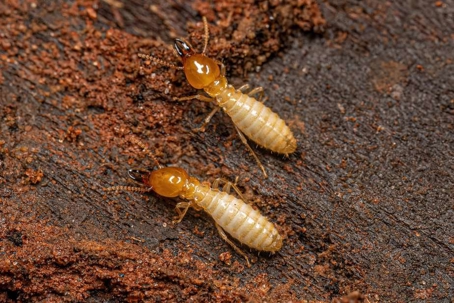Dr. Termites
Termites are among the most damaging pests a homeowner can face, largely due to how quietly they work. A solid grasp of the termite life cycle can help you understand how colonies develop, how infestations grow, and what steps you can take to prevent long-term damage. From winged swarmers to silent workers, each termite stage has a role in weakening your home from the inside out.
By learning how termites grow, reproduce, and survive, you can better protect your property and detect problems early, before they become expensive to fix.

The Termite Life Cycle: A Breakdown
Termites are social insects with a caste-based life cycle that allows them to grow large colonies efficiently. Understanding how each caste operates is critical to controlling infestations. The termite life cycle begins when reproductive swarmers (alates) leave an existing colony to mate and form new colonies. Once they land and shed their wings, they become the king and queen of a new termite nest.
There are four main stages in the termite life cycle:
- Egg: After mating, the queen lays eggs that hatch within a few weeks. These eggs are cared for by worker termites in the early stages of colony development.
- Nymph: Eggs develop into nymphs, which then differentiate into one of the three primary castes: workers, soldiers, or reproductive swarmers.
- Worker: These termites perform most of the labor, such as building tunnels, gathering food, and caring for the young. Workers are the ones most responsible for property damage.
- Soldier: Their role is to defend the colony. While they do not cause structural harm, their presence indicates a mature infestation.
As colonies mature, they send out more swarmers to expand. Depending on the species and environmental conditions, a colony can become fully established in just a few years and house hundreds of thousands of termites.
How Termite Behavior Leads to Property Damage
Worker termites are the primary culprits behind damage to homes. They feed on cellulose, a major component of wood and many building materials. The constant foraging and tunneling of worker termites gradually erodes structural supports, subfloors, and wooden framing.
Signs of infestation may not be obvious until the damage is advanced. By then, significant internal weakening may have occurred, potentially affecting the home’s stability and long-term value. These insects are also incredibly persistent and can continue to damage the property unnoticed for years.
If left untreated, termites can lead to extensive repairs and even compromise the safety of your home. For insight into why early intervention is critical, see this overview of the long-term impact of termite damage.
Key Warning Signs of an Active Colony
Early detection is one of the most effective ways to prevent widespread termite damage. Recognizing signs of termite activity can help homeowners take timely action before a colony becomes deeply rooted.
Be alert for the following indicators:
- Mud tubes along foundation walls, support beams, or exterior siding
- Discarded wings near windowsills, baseboards, or doorframes, especially during spring swarming season
- Hollow-sounding wood or bubbling paint, especially on baseboards or walls
- Frass (termite droppings) that resemble sawdust or black pepper
- Sagging floors or warped walls, which may indicate extensive internal tunneling
These signs typically point to an established infestation and warrant professional evaluation. Delaying action gives termites more time to expand and cause hidden damage.
Proactive Prevention Tips for Homeowners
Preventing termites begins with making your home a less attractive target. While some infestations are caused by environmental conditions, many can be avoided with regular maintenance and structural precautions.
Here are expert tips for prevention:
- Fix leaks and eliminate moisture around your foundation, plumbing, and roof
- Remove wood-to-soil contact by keeping decks, siding, and supports elevated
- Store firewood away from your home’s exterior and keep crawlspaces dry and ventilated
- Seal foundation cracks and repair damaged screens or vents
- Schedule annual inspections, especially in termite-prone regions like California
For California homeowners, routine evaluations are especially important due to the high termite activity across the state. Learn more about the importance of regular termite inspections and how they help protect your property year after year.
Why Professional Help Makes a Difference
Despite your best efforts, termite infestations can still occur, particularly in older homes or areas with high humidity and wood-rich environments. When signs appear or damage is suspected, professional assessment becomes essential.
Pest control professionals are trained to:
- Identify the termite species and locate nests or access points
- Evaluate the extent of damage using tools like moisture meters and thermal imaging
- Apply targeted treatments that eliminate the colony without harming your home
- Recommend long-term solutions, including soil treatments or localized wood treatments
- Monitor your home post-treatment to prevent reinfestation
Attempting to resolve a termite problem alone can result in missed colonies, improper treatment, and more damage over time. Trusted professionals can provide both immediate relief and long-term peace of mind.
Stop the Colony Before It Starts
The termite life cycle may be hidden underground or behind your walls, but its effects are anything but invisible. Learning how termites grow, reproduce, and feed helps you understand the risks they pose to your home. With early detection, practical prevention, and trusted professional support, you can keep these destructive pests from settling in.
If you’re ready to protect your home from termites or suspect they may already be active, contact Dr. Termites to schedule a professional inspection and take action before the damage spreads.
The post Understanding the Life Cycle of Termites: Prevention and Control appeared first on Dr. Termites.

